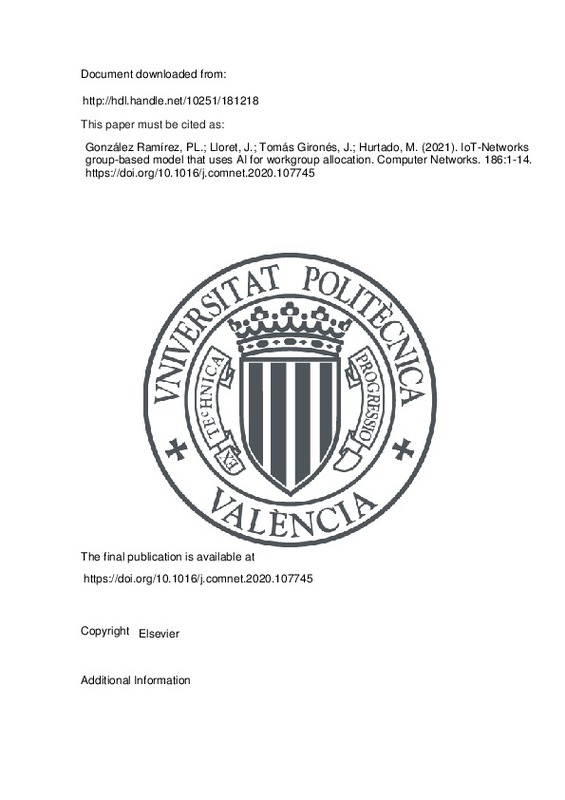JavaScript is disabled for your browser. Some features of this site may not work without it.
Buscar en RiuNet
Listar
Mi cuenta
Estadísticas
Ayuda RiuNet
Admin. UPV
IoT-Networks group-based model that uses AI for workgroup allocation
Mostrar el registro sencillo del ítem
Ficheros en el ítem
| dc.contributor.author | González Ramírez, Pedro Luis
|
es_ES |
| dc.contributor.author | Lloret, Jaime
|
es_ES |
| dc.contributor.author | Tomás Gironés, Jesús
|
es_ES |
| dc.contributor.author | Hurtado, Mikel
|
es_ES |
| dc.date.accessioned | 2022-03-02T19:02:26Z | |
| dc.date.available | 2022-03-02T19:02:26Z | |
| dc.date.issued | 2021-02-26 | es_ES |
| dc.identifier.issn | 1389-1286 | es_ES |
| dc.identifier.uri | http://hdl.handle.net/10251/181218 | |
| dc.description.abstract | [EN] This paper presents a centralized management architecture model for designing workgroup-based Internet of Things (IoT) and Internet of Everything (IoE) networks. The architecture establishes the organization of an object according to its functions and capacities in layers. From its model, it is derived the design of the algorithms that give the network operation. These algorithms include the multi-protocol communication and interconnectivity algorithm, the routing algorithm, the resource sharing algorithm, and the grouping algorithm, all controlled by Artificial Intelligence (AI). The grouping algorithm consists of creating collaborative workgroups based on Machine Learning (ML) techniques that use the objects' features to allocating these within a workgroup that attends a type of service and within an architecture layer according to its capabilities. The model was tested with a simulation that shows the Machine-to-Machine (M2M) interaction between the devices involved in providing a service to a user within a Smart Home. This simulation uses an AI hosted within an IoT-Gateway to collect data on the features that define a connected object's functions and services. The extraction of the features is done using the Discovery of Functions and Services Protocol (DFSP) transported through an IoT-Protocol. With this information, the AI assigns a layer and a workgroup to a new object when it enters the network. The result of these tests can be used to know which ML technique has better accuracy. | es_ES |
| dc.description.sponsorship | This work has been partially supported by the Ministerio de Economía y Competitividad in the Programa Estatal de Fomento de la Investigacion Científica y Tecnica de Excelencia, Subprograma Estatal de Generacion de Conocimiento within the project under Grant TIN2017-84802-C2-1-P. This work has also been partially supported by European Union through the ERANETMED (Euromediterranean Cooperation through ERANET joint activities and beyond) project ERANETMED3-227 SMARTWATIR. At the Univeridad Central (Colombia), to the Smart City work team of the MAXWELL research group, for their special interest in generating new contributions to the networks (IoT & IoE). | es_ES |
| dc.language | Inglés | es_ES |
| dc.publisher | Elsevier | es_ES |
| dc.relation.ispartof | Computer Networks | es_ES |
| dc.rights | Reconocimiento - No comercial - Sin obra derivada (by-nc-nd) | es_ES |
| dc.subject | IoT | es_ES |
| dc.subject | IoT-smart architecture | es_ES |
| dc.subject | IoT-gateway | es_ES |
| dc.subject | M2M protocols | es_ES |
| dc.subject | ML classifiers | es_ES |
| dc.subject | Collaborative workgroups | es_ES |
| dc.subject | Network model | es_ES |
| dc.subject | Graph theory | es_ES |
| dc.subject | Smart IoT-networks | es_ES |
| dc.subject.classification | INGENIERIA TELEMATICA | es_ES |
| dc.title | IoT-Networks group-based model that uses AI for workgroup allocation | es_ES |
| dc.type | Artículo | es_ES |
| dc.identifier.doi | 10.1016/j.comnet.2020.107745 | es_ES |
| dc.relation.projectID | info:eu-repo/grantAgreement/AEI/Plan Estatal de Investigación Científica y Técnica y de Innovación 2013-2016/TIN2017-84802-C2-1-P/ES/RED COGNITIVA DEFINIDA POR SOFTWARE PARA OPTIMIZAR Y SECURIZAR TRAFICO DE INTERNET DE LAS COSAS CON INFORMACION CRITICA/ | es_ES |
| dc.relation.projectID | info:eu-repo/grantAgreement/EC//ERANETMED3-227 SMARTWATIR/ | es_ES |
| dc.rights.accessRights | Abierto | es_ES |
| dc.contributor.affiliation | Universitat Politècnica de València. Departamento de Comunicaciones - Departament de Comunicacions | es_ES |
| dc.description.bibliographicCitation | González Ramírez, PL.; Lloret, J.; Tomás Gironés, J.; Hurtado, M. (2021). IoT-Networks group-based model that uses AI for workgroup allocation. Computer Networks. 186:1-14. https://doi.org/10.1016/j.comnet.2020.107745 | es_ES |
| dc.description.accrualMethod | S | es_ES |
| dc.relation.publisherversion | https://doi.org/10.1016/j.comnet.2020.107745 | es_ES |
| dc.description.upvformatpinicio | 1 | es_ES |
| dc.description.upvformatpfin | 14 | es_ES |
| dc.type.version | info:eu-repo/semantics/publishedVersion | es_ES |
| dc.description.volume | 186 | es_ES |
| dc.relation.pasarela | S\441238 | es_ES |
| dc.contributor.funder | European Commission | es_ES |
| dc.contributor.funder | Agencia Estatal de Investigación | es_ES |







![[Cerrado]](/themes/UPV/images/candado.png)

